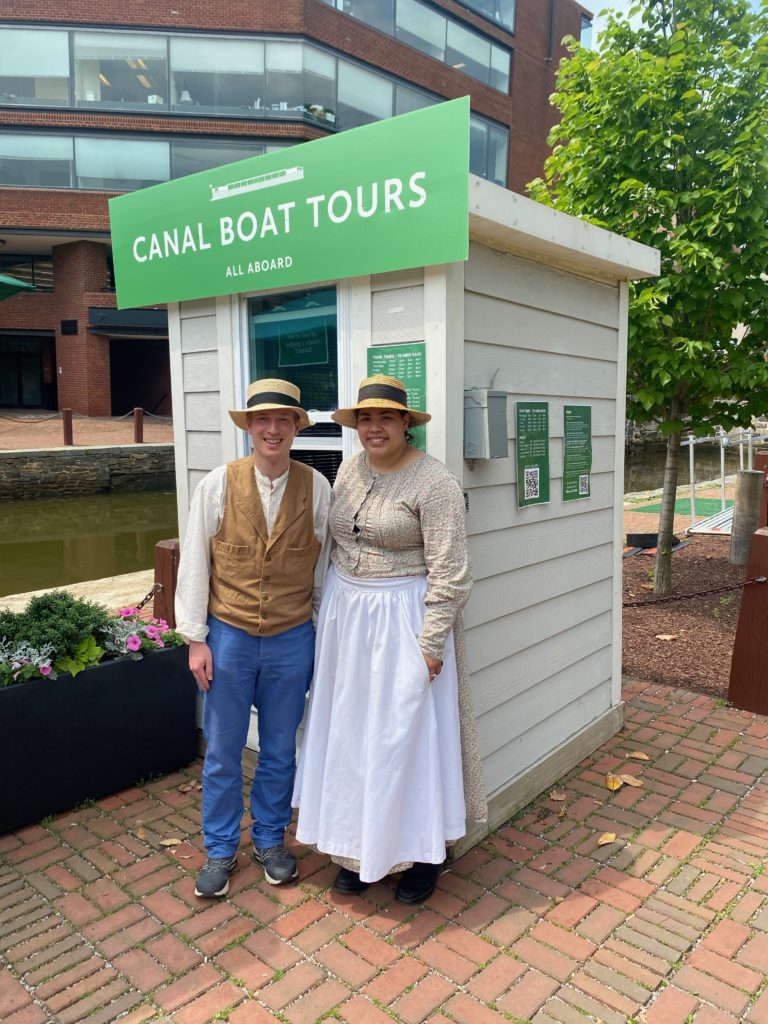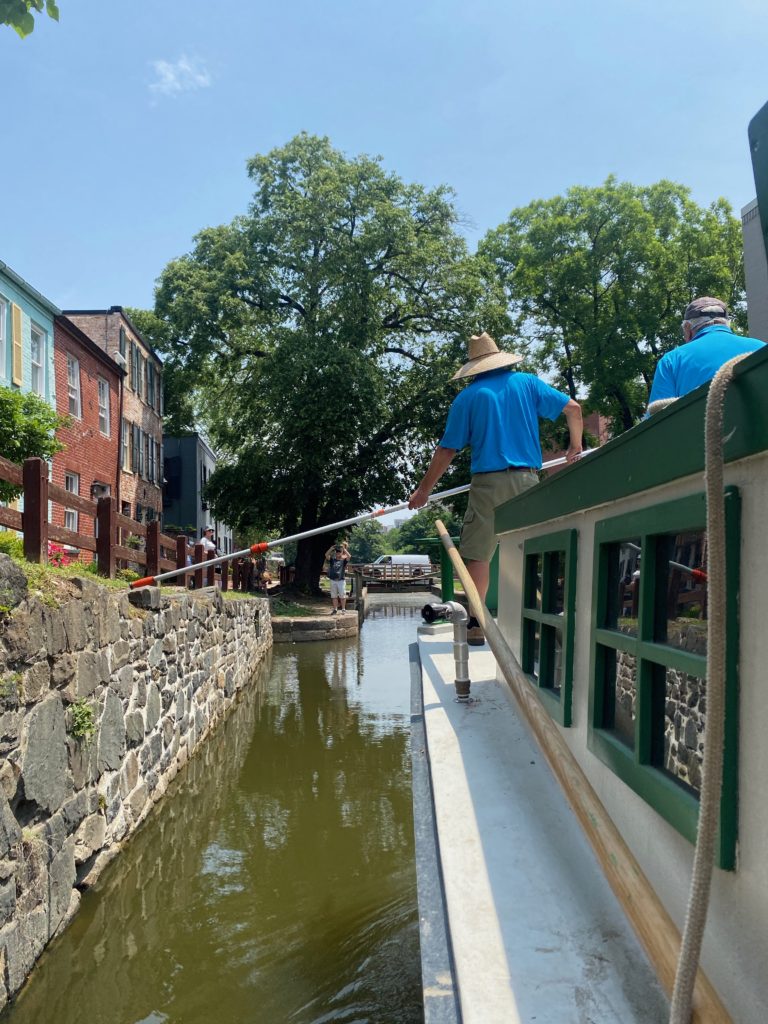A Ride Aboard the ‘Georgetown Heritage’
By • August 11, 2022 0 1994

At Lock 3 in Georgetown, on a recent sunny Friday afternoon, lines form near the ticketing kiosk along the towpath near 30th and Thomas Jefferson Streets NW. Eager ticket-holders soon board the brand new 80-foot canal boat. Seating about 60 passengers, the vessel is freshly appointed in white with green stripes, open-air windows and a tiller pilot in historical costume on the stern.
Once aboard and afloat on the one-hour, one-mile canal tour through Georgetown, under Key Bridge to the Aqueduct ruin and back to Lock 3, historical interpreters aboard teach the passengers “about the fascinating history, technology and culture of the C&O Canal, and the surprising stories of the people who lived, worked and played [there] over the past two centuries.”
For over a decade, Georgetown had been without its once treasured canal boat operated by the National Park Service. Many of the passengers flocking in for a ride on the Georgetown Heritage are therefore nostalgic about the joys of touring the canal aboard such a craft. Built for a cost of $1.5 million at Roudebush Yacht & Engine Works in Dundalk, Maryland, the “Georgetown Heritage” was modeled on designs for the historic packet boats that hauled goods such as coal, limestone, wood, lumber, sand, and flour along the Chesapeake and Ohio (C&O) Canal during its late 19th century heyday in Georgetown.
The original canal boat was towed by mules (hence the term “towpath”), but the “Georgetown Heritage” has several modern upgrades, including quiet electric engines fore and aft, restrooms and a sound-system.
Overlooking the Potomac River, the tour provides a delightful fresh-air excursion to take in the marvelous sights and sounds of the Georgetown section of the canal, at a 19th century pace, while also providing an historically immersive and thought-provoking experience.
Supreme Court Justice William O. Douglas is celebrated with a bust mounted in 1977 near the ticket kiosk. In 1954, he led a publicized and historic walk of the C&O Canal’s entire length – 184.5 miles from Georgetown, D.C. to Cumberland, Maryland – and back again, to save the canal from being turned into a scenic highway and to put it on the path to becoming a national park.

Historical interpreters await the next tour aboard the “Georgetown Heritage.” Photo by Chris Jones.
Once underway, costumed historical interpreters bring to life the C&O Canal’s rich history by providing historical snapshots from select years. For example, on Independence Day in 1828 – just 3 years after the opening of the Erie Canal – President John Quincy Adams inaugurated the C&O Canal with a lofty address near Georgetown. “The project contemplates a conquest of a physical nature such has never yet been achieved by man. The wonders of the ancient world. The pyramids of Egypt. The Colossus of Rhodes. The Wall of China. [All] sink into insignificance in the mass and momentum of human labor required for the purposes to be accomplished,” Adams heralded.

Historical interpreter sounds the horn aboard the “Georgetown Heritage.” Photo by Chris Jones.
Passengers hear about the prodigious feats of engineering required to construct the canal. “This lock is Lock 4 out of 74 lift locks on the canal,” an interpreter says. And the canal “changes in elevation about 605 feet” over its 184.5 miles.” Traversing the Allegheny Mountains and over its length, 11 aqueducts, 240 culverts, and numerous other necessary structures had to be built. “For 22 years, canal workers dug, using picks and shovels, and hauled out tons of earth with ox and mules, to shape the prism of the canal. No big cranes. No jackhammers. No backhoes. No dynamite. So, they had to use gunpowder….and chisels,” an interpreter says. The herculean feats of labor of the mostly Irish- and German-American laborers and indentured, possibly enslaved, African American workers who toiled to construct the canal for over 20 years are brought to life as well.

A young passenger points out the sights on the “Georgetown Heritage” boat tour. Photo by Chris Jones.
The interpreters give voice to runaways on the Underground Railroad routes along the canal, surprise passengers with the names of female and African-American canal boat captains who worked in Georgetown and describe the usually barefoot child “mule skinners” responsible for guiding the beasts of burden along the towpath. On the normally 7-day trip from Georgetown to Cumberland, passengers aboard a typical canal boat might eat turtle soup, eels, plentiful fish and game.

7. For deck hands, navigating the narrow passages of the C&O Canal can be challenging. Photo by Chris Jones.
With all of the interpreters’ stories, the one about 12-year-old Boy Scout Mark Stover stood out. Testifying before a U.S. Senate Sub-Committee in 1970 on behalf of making the C&O Canal into a National Park, young Stover began, “Members of the Committee and Mr. Chairman, I will speak [about] most of the Chesapeake and Ohio Canal on which I myself have enjoyed many adventures.” Emphasizing feats of engineering such as the “nearly one mile long” Paw Paw Tunnel through the Allegheny mountains of Maryland, Stover went on to highlight the “geological value” of the “rock formations, flat lands, mountains and nature ranging from different birds to snakes which are enjoyed by many Scouts for the passing of tests.” Famous battles including Williamsport, Fort Frederick, Antietam and Fort Pitt were fought near the canal. “John Brown hid at Harper’s Ferry right next to the canal until Robert E. Lee captured him with a fight,” and during the Civil War “Stonewall Jackson tried to destroy the dams of the canal, but failed,” Stover testified.
A year after young Stover’s testimony, President Nixon signed into law the bill establishing the entire C&O Canal as a National Park.
For information about tours aboard the “Georgetown Heritage,” go to Georgetownheritage.org.

